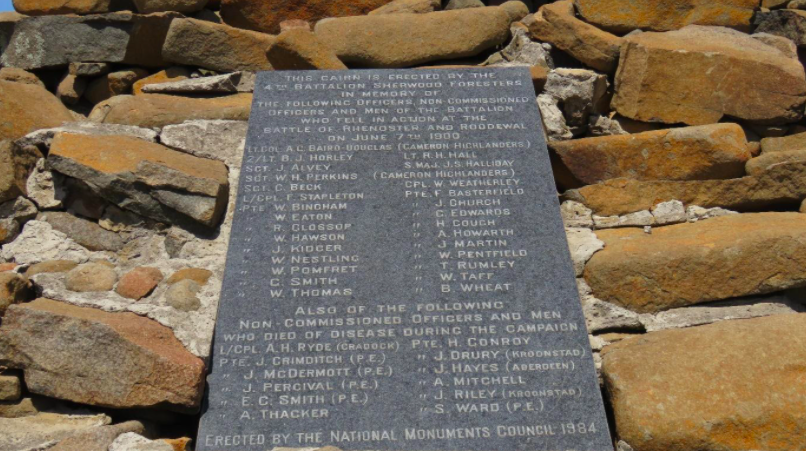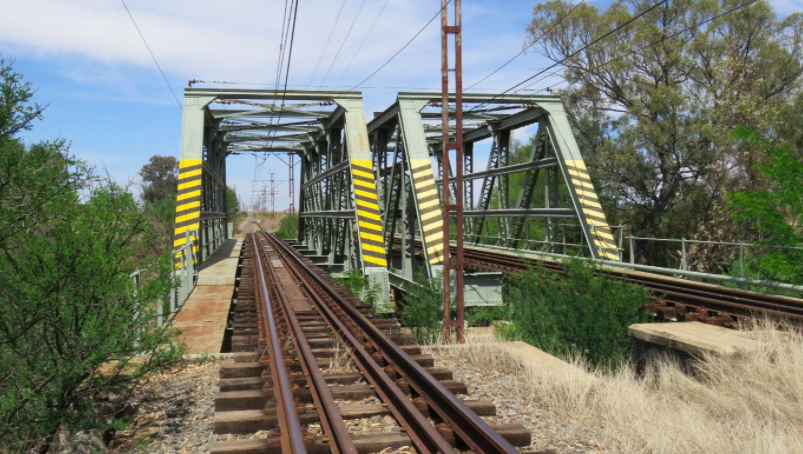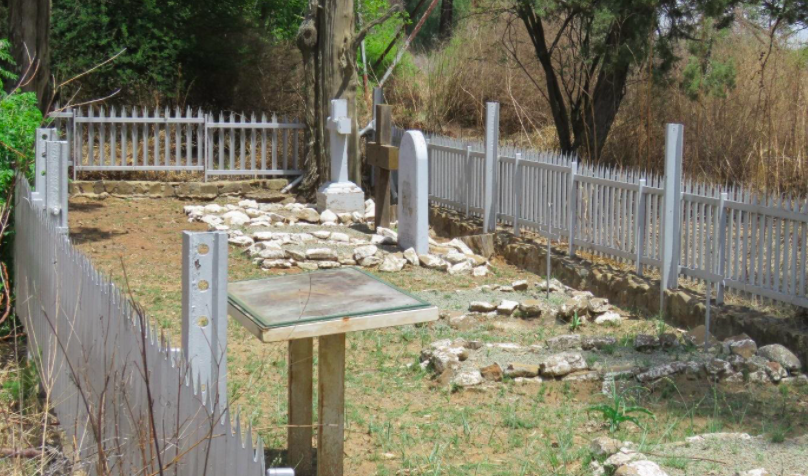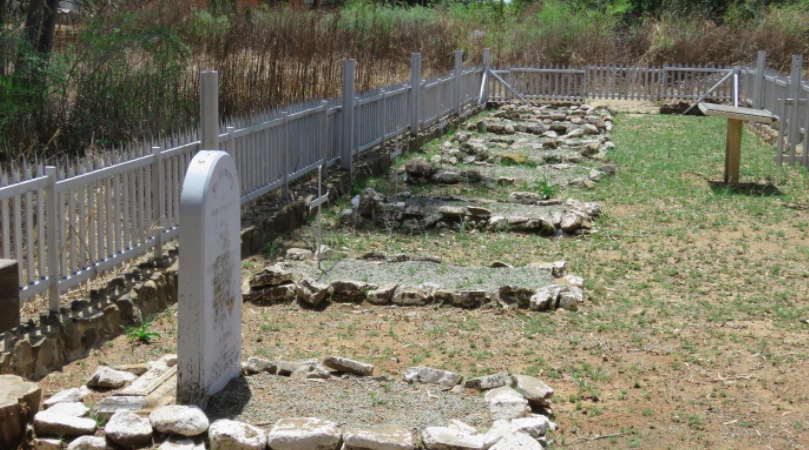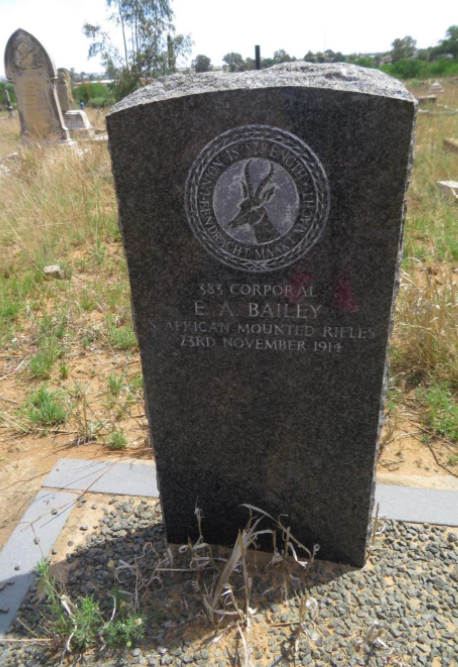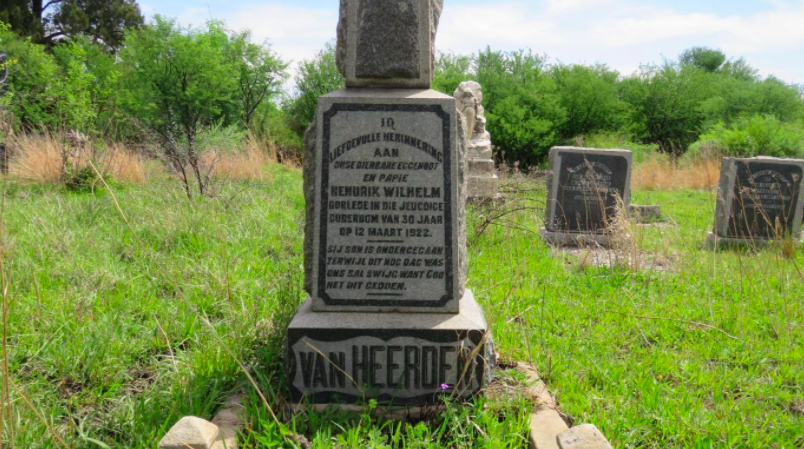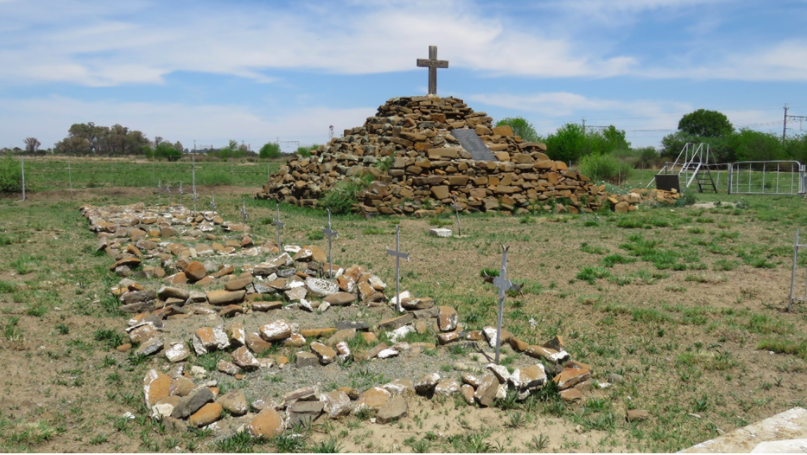
Disclaimer: Any views expressed by individuals and organisations are their own and do not in any way represent the views of The Heritage Portal. If you find any mistakes or historical inaccuracies, please contact the editor.
Recently, Sarah Welham, convenor of the Friends of the Johannesburg Cemeteries, and I completed an exploratory road trip of the battlefields route between Koppies and Kroonstad, in the northern Free State.
I had previously visited the interesting but somewhat out of the way war cemeteries near the Rhenosterspruit railway bridge and at the Rooiwal railway station, both near the town of Koppies. Here General Christiaan de Wet achieved important victories over three British contingents in June 1900. His victories came at just the right moment to rejuvenate the despondent republican forces whose capital cities of Bloemfontein and Pretoria had recently fallen to the seemingly irresistible British forces.
We also intended to visit the old Kroonstad cemetery, to my knowledge one of only three cemeteries that contains graves of three important South African military events: The South African War; the 1914 Afrikaner Rebellion; and the 1922 Rand Revolt.
Departing Johannesburg our first halt was at the Koppies town cemetery, where we hoped to locate graves of rebels killed during the 1914 Rebellion.
Koppies situated approximately 63 km north-east of Kroonstad was laid out in 1910 on the farm Honingkopjes, Dutch for ‘honey hills’. It was stablished as a private agricultural settlement by General Christiaan De Wet, Minister of Agriculture in the ‘Orangia Unie’ Party Cabinet to provide employment for poor Whites. After the establishment of the Union of South Africa in 1910, this settlement was taken over by the government and further developed. De Wet nevertheless continued to visit the settlement from time to time. In the weeks prior to the 1914 Rebellion, he addressed several meetings there to discuss how he and other concerned citizens should respond to the government’s decision to invade German South West Africa, following the outbreak of The Great War. Because of the esteem De Wet enjoyed within the Koppies community, it is not surprising most of the residents supported his rebellion against the intended invasion of the neighbouring German colony.
To our disappointment there were no graves from the 1914 Rebellion in the Koppies cemetery. Nevertheless, it was pleasing to note the cemetery was well maintained with trimmed shrubs lining the cemetery driveway.
We then proceeded about two kilometres south next to the railway line to the small military cemetery from the South African War, located a short distance north of the Rhenoster River railway bridge (see main photo). This gravel track was rather rough and best attempted in a vehicle with decent ground clearance.
Plaque on cairn at the military cemetery commemorating 15 men of the Sherwood Foresters killed in action at Rhenoster River and Rooiwal station on 7 June 1900. (SJ de Klerk)
Adjacent to the impressive stone cairn an informative granite plaque erected by the National Monuments Council in 1994, summarises the events of 4 to 7 June 1900:
A convoy of 56 British supply wagons en route to Heilbron surrendered to the Boers on the farm Zwavelskrans (Swallows’ Cliff) on 4 June 1900. General Christiaan de Wet followed up this successful operation on 7 June 1900 by launching simultaneous attacks on a large consignment of stores at Rooiwal (Roodewal) station, on a military construction camp at the Rhenoster River where the railway bridge was being repaired and on Greenlands (Vredefort Road). All three objectives were taken with 47 fatalities on the British side while one Burgher (P. M. Myburgh) of the Heilbron Commando was mortally wounded. These actions were part of the early guerrilla phase of the war and of great encouragement to the Boer forces whose morale at the time was at a low ebb.
De Wet divided his force into three columns. The northern group consisted of 300 men under Commandant Steenkamp with one cannon, with their objective being Vredefort Road; the main body with three field pieces and a Maxim under General Froneman was sent to attack the Derbyshires and Sherwood Foresters at the Rhenoster River bridge; while the third party, the smallest, was led by De Wet himself to Rooiwal. All three columns arrived at their destinations before daybreak of 7 June and achieved complete success.
A short drive south, still along the railway line, brought us to the Rhenoster River railway bridge. Here two companies of the Derbyshire Regiment and a contingent of the Sherwood Foresters totalling approximately 630 men held an outpost line of about 4 kilometres. Finding themselves surrounded, they fought bravely for 4 hours until suffering 36 dead and 104 wounded, they surrendered. The bridge over the Rhenoster River which had just been repaired by the Engineers was again destroyed.
Although this river is now bridged by a double railway line, during the war it was crossed by only a single railway line, that served as the main supplier of material and provisions to the British force on the Witwatersrand.
Rhenoster River railway bridge (SJ de Klerk)
The original railway line crossed the river over the righthand (western) bridge. On my previous visit an information tablet provided useful background on this engagement, but it is now gone.
We carefully drove back to Koppies and then veered south for about 15 kilometres to the Rooiwal railway station along the badly potholed R82. At Rooiwal station, dense vegetation on the platforms completely obscured the little military cemetery. Fortunately, having been there on prior occasions, I knew that it was situated on the far side of the twin railway tracks and close to the overhead walkways. Not trusting the integrity of the rusting overhead walkways we instead clambered across the railway line, nervously cracking jokes of films where the high heels of unfortunate ladies stuck to the tracks. Fortunately, Sarah wasn’t wearing high heels nor did any oncoming trains rush towards us during the crossing.
The Rooiwal garrison hearing of De Wet’s advance entrenched themselves as well as they could behind the railway embankment with the aid of the stores they had been guarding. The garrison under command of Captain A. W. G. Grant totalled 172 men.
Rooiwal military cemetery looking south towards the cross, marking Captain F. G. Gale’s grave. The information tablet in the foreground is illegible due to exposure to the elements (SJ de Klerk)
The fighting at Rooiwal was severe but even with his single cannon De Wet was unable to force the garrison to surrender. One British soldier commented, ‘The only thing that saved us from being cut to pieces was the good cover we had made from railway trucks, bales of clothing, boots, blankets and other stores, even the mail bags were used’.
But once the British garrison at Rhenoster River capitulated, De Wet reinforced his own small column with burghers from the main body and their guns. Then it was merely a matter of time before the garrison surrendered because of bombardment from all directions.
The Times History of the War in South Africa valued the accumulated stores at Rooiwal at £100 000, an enormous amount in those days. The Boers looted as much as they could and everything that could not be carried away was burned. Communications between Kroonstad and Pretoria were cut and the railway line for several kilometres completely broken up. Small arms and ammunition were also secreted at various places in the vicinity for future use by the Boer commandos.
The tombstone in the foreground commemorates Privates Hope, Maher, and Shimmin of the Pioneer Railway Regiment Killed in Action at Rooiwal on 7 June 1900 and Privates Ryan and Marshall who died of wounds and buried elsewhere. Also, Sergeant Pegg, Royal Engineers buried at Kroonstad. (SJ de Klerk)
We then departed for the old Kroonstad cemetery and time allowing, the adjacent Imperial Garden of Remembrance, in Noord Street. As we continued southwards on the potholed R83, I several times regretted not retracing my steps to Koppies to travel via the N1 to Kroonstad.
It was one of those hot Free State summer days, but fortunately Sarah’s sandwiches and my large Stanley flask of tea sustained and rehydrated us.
Kroonstad was laid out on the farm Klipplaatsdrift in 1855. The town is generally thought to have been named after a horse called Kroon, that belonged to either the Voortrekker Charl Cilliers or to ‘Lang’ Adriaan De la Rey, the father of General Koos De La Rey.
The old Kroonstad cemetery in Noord Street was used from circa 1904 to 1925. Here we found two tombstones from the 1914 Afrikaner Rebellion. Corporal E. A. Bailey of the SA Mounted Rifles who perished from a bullet wound while in action against rebels on 23 November 1914, near Hammanskraal north of Pretoria. This occurred when a contingent of the Pretoria Regiment, Enslin’s Horse and SA Mounted Rifles clashed with rebels commanded by Jacques Pienaar and Jopie Fourie on the farm Rondefontein approximately 10 kms north-east of Hammanskraal. After a heavy skirmish the government troopers withdrew having lost 4 men killed, amongst them Corporal Bailey, while the rebels suffered two killed.
Burgher S. J. Schoeman of Deniker’s Commando died of dysentery and heart failure on 27 November 1914. I have no knowledge of Deniker’s Commando and unfortunately Major G. Tylden’s normally authoritative The Armed Forces of South Africa is also silent about it.
Tombstone of Corporal Eric Alexander Bailey of the SA Mounted Infantry. Shot and killed on 23 November 1914. (Sarah Welham)
During the last two decades there has been new research free from dogma on the origins and reasons of the 1914 Rebellion, that some authors previously referred to as a kind of ‘midsummer madness’ or ‘vague malaise’. In total 11 372 Afrikaner men rebelled, 7 123 in the Orange Free State, 2 998 in the Transvaal and 1 251 in mainly the Northern Cape.
Certainly, one of the underlying reasons for the rebellion was the adverse effects that the 5 year long drought (starting in 1910) had on small farmers in the poorer districts of the Northern Free State and South-Western Transvaal. These two regions were the pivotal locations of the Rebellion. Patrick Duncan, who as a government representative involved with the investigation into the rebellion, perceptively declared: ‘But already in the long drought many of these people had lost what little they had, and rebellion does not seem such a serious thing to desperate men’.
Our next goal was to locate the tombstone of Police Constable Hendrik van Heerden. Lieutenant-Colonel R.S. Godley in his memoirs Khaki and Blue recalls how during the last days of the 1922 Rand Revolt, when a police contingent was desperately guarding the Brixton Ridge to prevent the strikers from uniting to take over the Johannesburg Town Hall, ‘Constable H. W. van Heerden became imbued with the unshakeable impression that he was going to be killed, although employed as a horse holder, and in comparative safety. As the sequel proved, he was shot through the head and killed instantaneously the following morning (12 March 1922) shortly after 3 a.m. when standing amongst the horses.’
When we finally reached the graves from 1922, at the south-western end of the cemetery, I was disappointed not to find any trace of Van Heerden’s grave and about to cease my search, when a joyous shout resounded nearby. Sarah had located his tombstone amongst others dating from 1924. It seems Van Heerden’s remains together with those of other policemen, members of the military and, strikers killed on the Brixton Ridge were initially buried in the temporary cemetery in the old Milner Park Showgrounds and only disinterred in 1924 for reinterment in their final grave sites. Hence, the reason why Van Heerden’s tombstone rests amongst others dating from 1924.
Tombstone of Constable H. W. Van Heerden who had an unshakeable premonition that he would be killed during the 1922 Rand Revolt, as he indeed was. (SJ de Klerk)
It is interesting to note the upper section of the epitaph is engraved in modern Afrikaans while the lower section is engraved in early Afrikaans derived from the Dutch.
Sarah and I have researched the number of fatalities killed during the 1922 Rand Revolt. While the 1922 Report of the Martial Law Inquiry Judicial Commission concluded 153 people were killed or died from their wounds, in addition to the four legally executed afterwards, the true number of fatalities appears to be closer to about 179. While most of the dead were interred in the Braamfontein, Brixton, Rynsoord, Primrose, Boksburg, Brakpan Mine Garden of Remembrance and Thaba Tswane Old No.1 cemeteries, there are an additional eleven cemeteries across the country, where some of the other fatalities were buried. But now we have at least located Constable Hendrik Van Heerden’s final resting place and shared his last fearsome and lonely hours of life with others. We trust he rests in peace.
Sarah and I can recommend this battlefield route to anyone interested in South Africa’s rich military history.
About the author: SJ De Klerk held many senior positions in HR during a distinguished career in the private sector. Since retiring he has dedicated time and resources to researching, exploring and writing about South African history.
Sources
- Amery L. S. The Times History of the War in South Africa. London. 1906.
- Bothma L. J. Rebelspoor. Die aanloop, verloop en afloop van die Boereopstand van 1914-15. Bloemfontein. 2017
- Godley R. S. Khaki and Blue. London. 1935.
- Grundlingh A. & Swart S. Radelose Rebelle. Dinamika van die 1914-1915 Afrikaner Rebellie. Pretoria 2009.
- Nienaber P. J. Suid-Afrikaanse Pleknaam Woordeboek. Johannesburg. 1972.
- Raper P. E., Möller L. A. & Du Plessis L. T. Dictionary of Southern African Place Names. Johannesburg. 2014.
- Report of the Martial Law Inquiry Judicial Commission. Pretoria. 1922.
- Scholtz L. Generaal Christiaan de Wet as veldheer. Pretoria. 2003.
- Tylden G. The Armed Forces of South Africa. Johannesburg. 1954.
Comments will load below. If for any reason none appear click here for some troubleshooting tips. If you would like to post a comment and need instructions click here.

